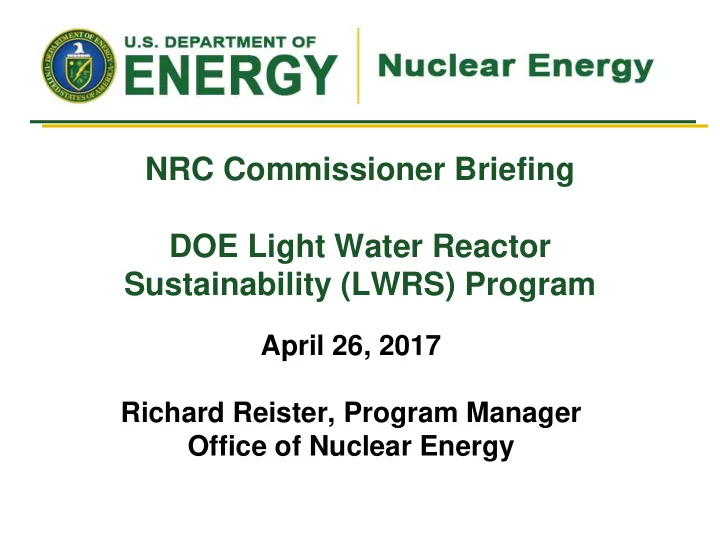

NRC Commissioner Briefing DOE Light Water Reactor Sustainability (LWRS) Program April 26, 2017 Richard Reister, Program Manager Office of Nuclear Energy
Projected Fleet Capacity 2
LWRS Program Objective: Develop technologies and other solutions that can improve the reliability, sustain the safety, and extend the life of current reactors Four areas of research: Materials Aging and Degradation Advanced Instrumentation, Information, and Control Systems Technologies Risk-Informed Safety Margin Characterization Reactor Safety Technologies 3
LWRS Program DOE Role: Support national strategic interests in energy security, reliability and grid stability Address fundamental scientific questions to make progress on broadly applicable technology issues Reduce technical uncertainties and risks such that industry is willing to make the necessary long-term investments Materials Research helps develop: High quality materials degradation data An understanding of the underlying mechanisms Mechanistic models Improved monitoring capabilities Mitigation techniques 4
Materials Aging and Degradation Expanded Materials Degradation Assessment (EMDA) (NUREG/CR-7153), a joint DOE/NRC sponsored effort published October 2014, captured status and knowledge gaps in the following four areas: Reactor Pressure Vessel (RPV) steels Core internals and piping systems Concrete civil structures Electrical power and instrumentation and control (I&C) cables Much progress has been made to fill knowledge gaps No generic technical show stoppers to long-term operation have been identified Research continues to improve understanding and reduce uncertainties 5
Reactor Pressure Vessels Evaluation of risk for high fluence embrittlement and possible mitigation techniques through the mechanistic understanding the effects of …… • Fluence, flux and influence of alloy Test Alloys: Completed mechanical and chemistry on materials performance microstructural exam of 60 of 180 alloys, testing • Radiation-induced effects and mitigation continues to 2020. techniques Modeling: 2017 - Model for transition • Neutron attenuation and variation in temperature shifts as a function of RPV chemistry and lifetime. through thickness properties Harvested Zion RPV: • Aging / irradiation behavior of weldments Currently machining samples, testing to continue to 2021. • Bias in toughness values derived from pre-cracked Charpy specimens 6
Core Internals Research involves analysis and testing of core internal materials of both commercial and 500 ° C 400 ° C model alloys and includes service materials. The goal is to develop physics based predictive models 2017 – Deliver Radiation Induce Microstructural Evolution (RIME) model for swelling 2017 – Complete an integrated thermal and radiation induced segregation model 2019 – Complete a predictive model for Irradiation-Assisted Stress Corrosion Cracking (IASCC) RIME code vs. experimental data These models can be used by industry to better predict, manage, and mitigate the degradation of core internals. 7
Piping Environmentally Assisted Fatigue Research has focused on experimental studies to develop a finite element based fatigue model that tracks key time-dependent properties for fatigue life based on LWR environmental conditions and plant operation history, rather than empirical methods using test data under non- relevant conditions. 2017 – Complete thermal fatigue models for a 508 Low Alloy Steel RPV and 316L alloy surge line pipe. Thermal Aging of Cast Austenitic Stainless Steel (CASS) and Austenitic Stainless Steel Welds (ASSW) Research the effects of long-term thermal exposure on the service life of CASS and ASSW components. 2019 – Complete a validated predictive model. Future work – address synergistic effects of irradiation and thermal aged CASS materials. 8
Concrete Civil Structures Conducting research on the fundamental behavior of the heavily reinforced concrete found in nuclear power plants under the influence of irradiation and Alkali-Silica Reaction (ASR) Irradiation studies on mineral analogues, aggregates and concrete, with data retained in a developed database Conducting experiments on ASRs influence on the structural ASR cracking in unconfined block significance to large reinforced structures 2020 – Complete a model tool to predict the impact of both irradiation and ASR on concrete structural performance. Based on research to date and initial evaluations, concrete structures appear to have significant safety margins during the 60-80 year time period. Concrete NDE Construction of ASR test blocks Improved existing NDE techniques by using advanced signal processing techniques. 9
Power and I&C Cables Understanding cable degradation mechanisms and the ability to predict remaining useful life will help plants better manage the aging of their cables Research is being conducted on the typical cable types found at plants Accelerated aging under combined temperature and irradiation conditions Electrical, chemical, and mechanical characterization is performed to establish aging trends and key factors for cable condition monitoring Also evaluating and developing promising Non-Destructive Evaluation (NDE) Power cable methods and technologies through collaboration with vendors and industry Current model development Multi-conductor 2019 – complete a predictive models for cable aging under combined thermal I&C cables and irradiation conditions We believe the aging of plant cable during the 60 to 80 year period of operation can be reasonably managed with appropriate monitoring programs. 10
Summary No generic technical show stoppers to long- term operation have been identified Supporting the development of improved monitoring techniques Inform industry Aging Management Programs 11
Recommend
More recommend